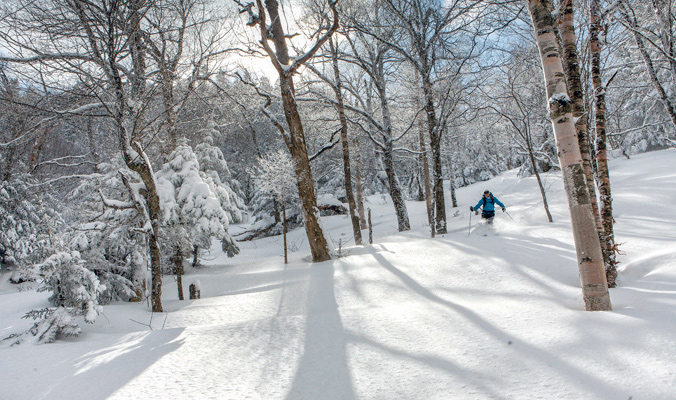
Emily Johnson does a modern twist down the Ranch Valley CCC trails near Stowe, VT. [Photo] Brain Mohr
A friend once threatened me to never write about the Bolton Valley backcountry. He offered no specific ultimatum, but I’ve long respected his wishes because the land on the southern end of Mt. Mansfield State Forest over the ridge above my Jericho home is one my favorite areas to ski, too.
Between a winding Nordic network, long-distance point-to-point routes that trace the Green Mountains’ spine and ample glades that snake through tangled birches, the only thing more extensive than Bolton’s offerings is its legacy. And that history—which predates most Northeastern skiing—is as essential to the story of Vermont’s backcountry as Johnson Woolen Mill pants and the motivation to push beyond the underbrush. So here it goes.
Edward Soheir Bryant cut the first ski trails high on the flanks of Bolton (3,690 ft.), Ricker (2,896 ft.) and Woodward (3,100 ft.) Mountains in the 1920s. After earning a degree from Harvard’s school of forestry, the youngest son of a Massachusetts physician opened a Boston-based forestry consultation business, worked for the U.S. Forest Service and became a commissioned officer with the U.S. Army, stationed in France during World War I. He then arrived in Vermont in 1922. There, above the Winooski River between the towns of Jonesville, Underhill and Stowe, Bryant purchased the first of 10,000 acres from a Connecticut-based timber company and set about reforesting the land, according to research by Ann Gotham, a coordinator with the Friends of Bolton Valley Nordic & Backcountry. Bryant built three cabins and cut a dozen or so ski trails alongside famed ski instructor Otto Schniebs. But after his untimely death in 1951 or 1952—records aren’t clear—Bryant’s trails faded into the landscape.
“His land holdings must have been extensive,” Gotham writes. “After [World War II] he tried but failed to get backing to build a rope tow and a base lodge.”
Twenty years later—after another Massachusetts family, the DesLauriers, opened Bolton Valley Ski Area on Bryant’s old land in 1968—a group of skiers would rediscover the forester’s trails and revive his legacy. They included Johannes von Trapp, Clem Holden and Gardiner Lane, the latter two who’d go on to organize a trail-stewardship fraternity known as the Old Goats. According to ski historian David Goodman, Lane, then president of the Green Mountain Club, and von Trapp cut nine miles of trail along the eastern shoulder of the Green Mountains in 1972. The Bolton-Trapps Trail, as it became known, dove from Bolton among birch glades into Mt. Mansfield State Forest’s Nebraska Notch before ascending to von Trapp’s 27-room lodge that had been welcoming guests to Stowe for two decades.
Lane kept busy that year—along with Holden, he cut back some of Bryant’s original trails and began carving an eastbound route off Woodward Mountain toward Waterbury Reservoir. While the route wound though open terrain that had been logged before and after Bryant’s era, the duo abandoned the project before they reached the reservoir, some five miles and 2,500 feet below.
In 1994, Goodman says, some Catamount Trail Association members found a trail sign indicating Lane and Holden’s handiwork and approached the Old Goats about finishing the trail. Three years later, the two men and several other individuals descended the inaugural run of the Woodward Trail. Holden was 73, and Lane was 83.
“Gardiner was a perfect skier—really stylish,” Holden reminisced to Goodman in a 2012. “He never went fast. None of us did.”
Fast or not, these individuals laid the groundwork for an expansive network overshadowed by the trails cut by the Civilian Conservation Corps in the 1930s and ’40s. To this day, the Friends of Bolton Valley Nordic & Backcountry still organizes Old Goat workdays to clip and clear Bolton-area trails. And when more than 1,000 acres of this land went up for sale in 2012, these groups, along with the Vermont Land Trust, led the effort to purchase the acreage for $1.8 million. That land is now forever part of Mt. Mansfield State Forest.
So while Bryant and the Old Goats get plenty of credit for creating and maintaining these favorite glades and trails, they deserve ample thanks for protecting them, too. And that’s perhaps the most important reason to tell Bolton’s backcountry story. During that fundraiser, Clem Holden wrote the first check—for $5,000.











Shhhhhhhh dude. Yer gonna roon it! Lol